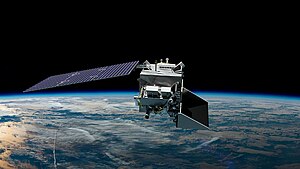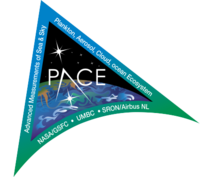
Summary
Plankton, Aerosol, Cloud, ocean Ecosystem (PACE) is a NASA Earth-observing satellite mission that will continue and advance observations of global ocean color, biogeochemistry, and ecology, as well as the carbon cycle, aerosols and clouds.[3] PACE will be used to identify the extent and duration of phytoplankton blooms and improve understanding of air quality.[4] These and other uses of PACE data will benefit the economy and society, especially sectors that rely on water quality, fisheries and food security.[5]
 An artist's concept of NASA's PACE spacecraft in orbit. | |
| Names | Pre-Aerosol, Cloud, and ocean Ecosystem PACE |
|---|---|
| Mission type | Remote sensing |
| Operator | NASA |
| COSPAR ID | 2024-025A |
| SATCAT no. | 58928 |
| Website | pace |
| Mission duration | 3-10 years (planned) 2 months, 15 days (in progress) |
| Spacecraft properties | |
| Spacecraft | PACE |
| Manufacturer | Goddard Space Flight Center |
| Launch mass | 1694 kg |
| Dimensions | 1.5 x 1.5 x 3.2 meters |
| Power | 1000 watts |
| Start of mission | |
| Launch date | 8 February 2024, 06:33 UTC [1] [2] |
| Rocket | Falcon 9 Block 5 |
| Launch site | Cape Canaveral, SLC-40 |
| Contractor | SpaceX |
| Orbital parameters | |
| Reference system | Geocentric orbit (planned) |
| Regime | Sun-synchronous orbit |
| Altitude | 676.5 km |
| Inclination | 98.0° |
| Period | 2-day global coverage 60° instrument view angle |
| Transponders | |
| Band | S-Band - Command & Telemetry Ka-Band - Science Data |
| Instruments | |
| Ocean Color Instrument (OCI) Spectro-Polarimeter for Planetary Exploration (SPEXone) Hyper-Angular Rainbow Polarimeter #2 (HARP2) | |
 PACE mission logo | |
After being proposed for cancellation under President Trump's FY 2018 budget, it was restored by Congress.[6] The PACE project is managed by NASA Goddard Space Flight Center.[7] The main instrument and bus were designed and built at Goddard Space Flight Center.[8]
On 4 February 2020, NASA announced the selection of SpaceX to launch PACE on a Falcon 9, at a total cost to NASA of US$80.4 million, including the launch service and other mission-related costs.[9] The total cost of the mission is $964 million, which includes spacecraft construction, launch, and operations.[10] PACE successfully launched on 8 February 2024 at 06:33 UTC.[11]On 17 April 2024 it was announced that first operational data was received.[12]
History edit
The Pre-Aerosol, Cloud, and ocean Ecosystem satellite (PACE)[13] was approved to move forward out of its preliminary stage of planning on 16 June 2016 at the Key Decision Point-A (KDP-A) event. According to project manager Andre Dress, a significant milestone for the next stage was that the official mission budget became available for use on 1 July 2016.[8]
Science overview edit
PACE has two fundamental science goals: "to extend key systematic ocean color, aerosol, and cloud data records for Earth system and climate studies, and to address new and emerging science questions using its advanced instruments, surpassing the capabilities of previous and current missions".[3] The ocean and atmosphere are directly connected, moving and transferring energy, water, nutrients, gases, aerosols, and pollutants. Aerosols, clouds, and phytoplankton can also affect one another.[3]
PACE will measure atmospheric particles and clouds that scatter and absorb sunlight. Improved characterization of aerosol particles will enable quantifying their impact on marine biology and ocean chemistry, as well as Earth's energy budget and ecological forecasting.[3] PACE will enable scientists to better monitor fisheries, identify harmful algal blooms, and observe changes in marine resources. The color of the ocean is determined by the interaction of sunlight with substances or particles present in seawater such as chlorophyll, a green pigment found in most phytoplankton species. By monitoring global phytoplankton distribution and abundance, the mission will contribute toward understanding the complex systems that drive ocean ecology.[3]
Scientific instruments edit
The oceans play a critical role in supporting life on Earth as well as the global economy. To understand changes in ocean health related to climate change;[3] formulation of science objectives and sensor requirements for an advanced ocean biology satellite mission began in the year 2000 with a NASA agency-wide carbon cycle initiative that included ocean, terrestrial, and atmospheric disciplines.
The instrument requirements for this ocean ecology mission are:[3]
- Ocean Color Instrument (OCI), primary sensor, is a highly advanced optical spectrometer that will be used to measure properties of light over portions of the electromagnetic spectrum. It will enable continuous measurement of light at finer wavelength resolution than previous NASA satellite sensors, extending key system ocean color data records for climate studies.[14] It is capable of measuring the color of the ocean from ultraviolet to shortwave infrared.[14] Wavelengths UV (350-400 nm), visible (400-700 nm), and near-infrared (700-885 nm), as well as several shortwave infrared bands.[3]
- Spectro-Polarimeter for Planetary Exploration (SPEXone) is a multi-angle polarimeter that provides continuous wavelengths coverage in the range 385-770 nm. It measures the intensity, Degree of Linear Polarization (DoLP) and Angle of Linear Polarization (AoLP) of sunlight reflected back from Earth's atmosphere, land surface, and ocean. The focus of the SPEXone development is to achieve a very high accuracy of DoLP measurements, which facilitates accurate characterization of aerosols in the atmosphere. It observes a ground pixel under 5 viewing angles (0°, ±20° and ±58° on ground), where the ±20° viewports will be used for cross calibration with the OCI. Aerosols are small solid or liquid particles suspended in the air that affect climate directly through interaction with solar radiation. Aerosols affect climate indirectly by changing the micro- and macro-physical properties of clouds. According to the Intergovernmental Panel on Climate Change, aerosols are the largest source of error in quantifying the radiative forcing of climate change. SPEXone will enable measurements of optical and micro-physical properties of aerosols with unprecedented detail and accuracy.[15]
- Hyper-Angular Rainbow Polarimeter #2 (HARP2) is a wide angle imaging polarimeter designed to measure aerosol particles and clouds, as well as properties of land and water surfaces. The amount and type of particles in suspension in the atmosphere are relevant to applications pertaining to health effects, cloud life cycle and precipitation, climate, etc. HARP2 will combine data from multiple along track viewing angles (up to 60), four spectral bands in the visible and near infrared ranges, and three angles of linear polarization to measure the microphysical properties of the atmospheric particles including their size distribution, amount, refractive indices and particle shape. HARP2 will be designed and built by University of Maryland, Baltimore County (UMBC)'s Earth and Space Institute.[16] The HARP2 instrument was preceded by HARP (HyperAngular Rainbow Polarimeter), a NASA cubesat that was launched to the ISS on 2 November 2019, deployed from the ISS on 19 February 2020, achieved first light on 15 April 2020 and decayed from orbit on 4 April 2022. COSPAR 1998-067QZ, SATCAT 45256.[17][18]
Mission edit
Launch edit
PACE was launched on 8 February, 2024, at a 1:33 am EST instantaneous launch window, on a SpaceX Falcon 9 rocket from Cape Canaveral Space Launch Complex 40, after two days of delays caused by bad weather. Shortly after launch, the rocket performed a dogleg maneuver to place it in a southbound trajectory. After first stage separation, the Falcon 9 booster performed a boostback burn and returned to land on the launch site, where it will be refurbished and reused on future flight. This was the fourth flight of this particular booster, which is designated B1081. The second stage of the rocket propelled PACE into its final orbit at an altitude of 676.5 kilometers, and the spacecraft was separated about 13 minutes after launch.[19][10]
Unusual for an east coast launch, this was a polar launch that placed the spacecraft into a Sun-synchronous orbit, a type of orbit commonly used on observation satellites because it sees a given spot on Earth at the same time every day. These launches are usually carried out from Vandenberg Space Force Base in California, to prevent debris from landing on populated areas, but SpaceX resumed polar launches from Florida in 2020 because of its ability to land the Falcon 9 booster safely and the introduction of the Autonomous Flight Safety System on the Falcon rockets. PACE was the first US government mission to launch to a polar orbit from Florida since 1960. The choice to launch PACE from Florida was simply a matter of convenience, due to it being located closer to the Goddard Space Flight Center, where the mission is operated.[19][20][10]
The cost of the launch was $80.4 million.[19] After launch PACE entered a 60-day commissioning period before publication of data. [10]
See also edit
References edit
- ^ "SpaceX launches NASA's PACE satellite to study Earth's oceans, air and climate". 8 February 2024. Retrieved 8 February 2024.
- ^ "Liftoff! NASA's Earth Science Mission Launches Into Space Coast Sky". NASA (Press release). 8 February 2024. Retrieved 8 February 2024.
- ^ a b c d e f g h "PACE". NASA. Retrieved 15 March 2021. This article incorporates text from this source, which is in the public domain.
- ^ "IOCCG News February 2021". IOCCG. February 2021. Retrieved 15 March 2015.
- ^ Foust, Jeff (24 May 2018). "Bridenstine offers senators reassurances on NASA programs". SpaceNews. Retrieved 15 March 2021.
- ^ Foust, Jeff (22 March 2018). "NASA receives US$20.7 billion in omnibus appropriations bill". SpaceNews. Retrieved 15 March 2021.
- ^ "New NASA Mission to Study Ocean Color, Airborne Particles and Clouds". 13 March 2015. Retrieved 15 March 2021. This article incorporates text from this source, which is in the public domain.
- ^ a b "NASA's PACE Mission Will Uncover New Information About Health of Our Oceans". NASA. 20 July 2016. Retrieved 15 March 2021. This article incorporates text from this source, which is in the public domain.
- ^ Clark, Stephen (5 February 2020). "SpaceX wins contract to launch NASA's PACE Earth science mission". Spaceflight Now. Retrieved 15 March 2021.
- ^ a b c d Stephen Clark. "NASA launches a billion-dollar Earth science mission Trump tried to cancel". Ars Technica. Retrieved 8 February 2024.
- ^ "NASA Invites Media to Launch of New Mission to Study Oceans, Clouds". NASA (Press release). 11 December 2023. Retrieved 11 December 2023.
- ^ "NASA's Near Space Network Enables PACE Climate Mission to 'Phone Home' - NASA". 17 April 2024. Retrieved 18 April 2024.
- ^ "Pre-Aerosol, Cloud, and ocean Ecosystem (PACE) Mission" (PDF). NASA. 31 March 2015. Retrieved 15 March 2021. This article incorporates text from this source, which is in the public domain.
- ^ a b "Ocean Color Instrument (OCI)". NASA. Retrieved 15 March 2021. This article incorporates text from this source, which is in the public domain.
- ^ "SPEXone Polarimeter". NASA. Retrieved 15 March 2021. This article incorporates text from this source, which is in the public domain.
- ^ "HARP2 Polarimeter". NASA. Retrieved 15 March 2021. This article incorporates text from this source, which is in the public domain.
- ^ Martins, J. Vanderlei (23 June 2020). "HARP: Hyper-Angular Rainbow Polarimeter CubeSat" (PDF). NASA. UMBC. Retrieved 5 February 2021.
- ^ Krebs, Gunter (14 January 2023). "HARP". Gunter's Space Page. Retrieved 11 December 2023.
- ^ a b c Justin Davenport. "Falcon 9 launch PACE science satellite for NASA". NASASpaceFlight. Retrieved 8 February 2024.
- ^ Jeff Foust. "Falcon 9 launches PACE Earth science mission". Spacenews. Retrieved 8 February 2024.
External links edit
- PACE mission home page
- NASA Ocean Color


